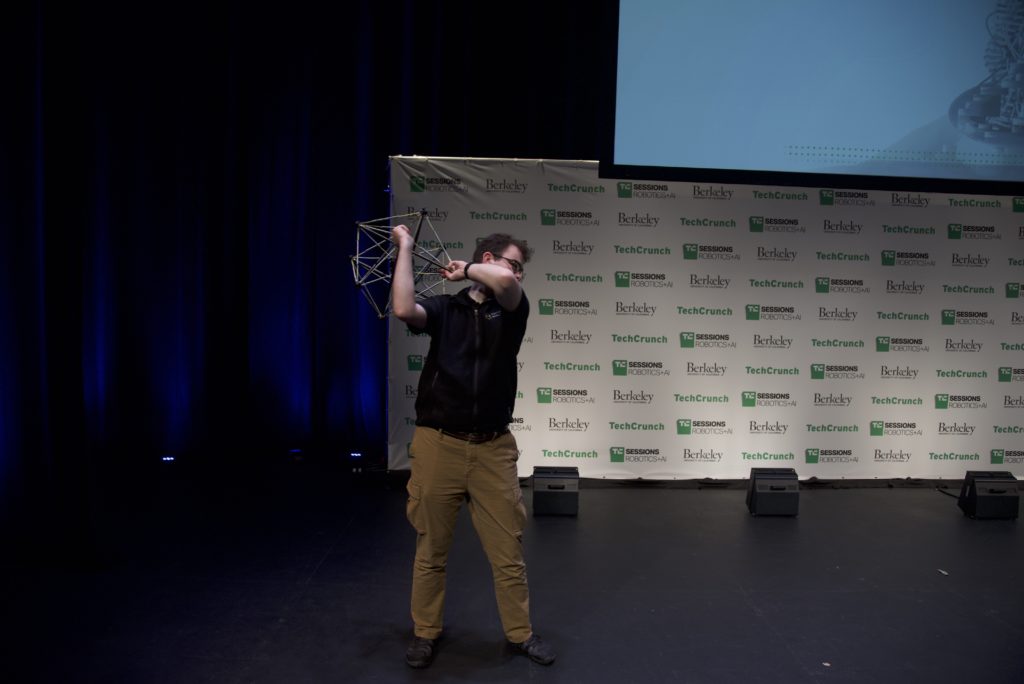Squishy Robotics was invited to demo at TechCrunch Robotics+AI on Thursday, April 18, 2019. Alice Agogino, CEO of Squishy Robotics and Professor of Mechanical Engineering at UC Berkeley, led the demo through backdrop videos of field testing, supplemented by stage demos by the Squishy Robotics team. Notably lead mechatronics engineer Doug Hutchings threw a stationary tensegrity across the stage and he and mechatronics engineer Anthony Thompson played pitch and catch with another tensegrity to demonstrate how Squishy Robotics compliant structures protect them during high impacts. This also demonstrates how the “squishy” properties makes then safe around humans, allowing them to be co-robots or partners to human-robotic teams.

TechCrunch journalist Devin Coldeway published an article titled: How Squishy Robotics created a robot that can be safely dropped out of a helicopter that was released the day of the demo.
Excerpts:
The startup has been operating more or less in stealth mode, emerging publicly today onstage at our Robotics + AI Sessions event in Berkeley, Calif. It began, co-founder and CEO Alice Agogino told me, as a project connected to NASA Ames a few years back.
“The original idea was to have a robot that could be dropped from a spacecraft and survive the fall,” said Agogino. “But I could tell this tech had earthly applications.”
Her reason for thinking so was learning that first responders were losing their lives due to poor situational awareness in areas they were being deployed. It’s hard to tell without actually being right there that a toxic gas is lying close to the ground, or that there is a downed electrical line hidden under a fallen tree, and so on.
Robots are well-suited to this type of reconnaissance, but it’s a bit of a Catch-22: You have to get close to deploy a robot, but you need the robot there to get close enough in the first place. Unless, of course, you can somehow deploy the robot from the air. This is already done, but it’s rather clumsy: picture a wheeled bot floating down under a parachute, missing its mark by a hundred feet due to high winds or getting tangled in its own cords.
Squishy’s solution can’t quite be dropped from orbit, as the original plan was for exploring Saturn’s moon Titan, but they can fall from 600 feet, and likely much more than that, and function perfectly well afterwards. It’s all because of the unique “tensegrity structure . . .
Squishy Robotics, Inc. has received seed funding from the SkyDeck Fund and non-dilutive funding from the National Science Foundation with SBIR (#1747189) and I-Corp (#1748774) grants.
See the full article at TechCrunch and video of TechCrunch presentation moderated by Caroline Winnett, Executive Director of Berkeley SkyDeck.

Also see related articles:
- Reposts of TechCrunch: The TECH Show.tv, TechNewsExplore and MarketingTechie
- IEEE Spectrum review of robots at TechCrunch 2.0
- Electronic Component News (ECN): Squishy Robots Can Drop from Helicopter and Land Safely
- I-Connect007: Squishy Robots Can Drop from a Helicopter and Land Safely
- Robotics Research: Squishy Robots Can Drop from a Helicopter and Land Safely
- Newswire Report: Squishy Robots Can Drop from a Helicopter and Land Safely
- Science & Technology Research News: Squishy Robots Can Drop from a Helicopter and Land Safely
- UC Berkeley News: Squishy robots can drop from a helicopter and land safely.
- Sohu Technology: The female professor leads the way to create the most durable robot, which can be lowered from a height of 180 meters to perform rescue missions.
- IFLScience!: Squishy Robot Can Be Dropped From 600 Feet And Helps Save Lives
- Futurity Research News: Squishy Robots Roll Into Action After 600-Foot Fall. Repost in Design Products & Applications.
- Lab Manager: Squishy Robots Can Land Safely from Helicopter
- UC Berkeley News: Squishy robots can drop from a helicopter and land safely
- N+1: Robot cameraman is launched from a helicopter and managed to keep recording!
- Daily Mail: ‘Squishy robots’ can fall up to 600 FEET from a helicopter without getting damaged and could provide first responders with critical information about conditions on the ground. Reposted in AAAI AITopics
- iRobot News: Squishy Robotics, a robot that does not break even from a helicopter, can be used as a reconnaissance robot
- BauBlatt News: Fantastic elastic: robots for distant planets and crisis areas
- autoevolution: Ball-Shaped Squishy Robots Can Drop from 600 feet and Survive
- Israeli Homeland Securing (i-his.com): Robot dropped from air to help first responders
- TechXplore: Squishy robots can drop from a helicopter and land safely
- Red Bull: The first response robot diving into disaster zones to save lives
- NBC News MACH: These squishy robots are designed to survive falls, save lives – The spindly bots carry video cameras and electronic sensors to gather information about conditions on the ground before emergency crews go in. Also reposts on MSN, Tech2 and The Breaking News Headlines.
- Daily Cal: Berkeley startup develops squishy robots to aid disaster rescue
- New York Post: These ‘squishy’ emergency robots are designed to save lives
- ZDNet: Emergency responders drop this squishy robot from 600 feet – Robots can go where people can’t. Getting them there is the big challenge
- The National: Squishy robots that can be dropped from the helicopter, saves human lives
- Tech The Lead: These Robots Plan to Become the Eyes and Ears of First Responders
- Robotics Tomorrow: Squishy Robotics Unveils Mobile Sensor Robots that Detect Hazards and Increase Safety for First Responders and the Public
- newscgtn.com. Robotic Future: TechCruch Sessions showcase assistive technologies in California. ALICE AGOGINO, CO-FOUNDER & CEO SQUISHY ROBOTICS “It can drop from heights, and it can walk. And that shape is what enables it to do all these functions. It’s got six cameras in them, 360 degree views as it’s dropping and then it continues providing the life-saving information when it hits the ground. It also has sensors in it.”
- Smart 2.0: Air-deployable mobile sensor robots to aid first responders
- CBRNe (Chemical, Biological, Radiological, Nuclear, explosive) World: Dropping robots from the sky
- Yahoo! Finance: Squishy Robotics Unveils Mobile Sensor Robots that Detect Hazards and Increase Safety for First Responders and the Public
- Reposts of TechCrunch: The TECH Show.tv, TechNewsExplore and MarketingTechie
- IEEE Spectrum review of robots at TechCrunch 2.0
- Electronic Component News (ECN): Squishy Robots Can Drop from Helicopter and Land Safely
- I-Connect007: Squish Robots Can Drop from a Helicopter and Land Safely
- UC Berkeley News: Squishy robots can drop from a helicopter and land safely.
- Sohu Technology: The female professor leads the way to create the most durable robot, which can be lowered from a height of 180 meters to perform rescue missions.
- IFLScience!: Squishy Robot Can Be Dropped From 600 Feet And Helps Save Lives
- Futurity Research News: Squishy Robots Roll Into Action After 600-Foot Fall. Repost in Design Products & Applications.
- Lab Manager: Squishy Robots Can Land Safely from Helicopter
- UC Berkeley News: Squishy robots can drop from a helicopter and land safely
- N+1: Robot cameraman is launched from a helicopter and managed to keep recording!
- Daily Mail: ‘Squishy robots’ can fall up to 600 FEET from a helicopter without getting damaged and could provide first responders with critical information about conditions on the ground. Reposted in AAAI AITopics
- iRobot News: Squishy Robotics, a robot that does not break even from a helicopter, can be used as a reconnaissance robot
- BauBlatt News: Fantastic elastic: robots for distant planets and crisis areas
- autoevolution: Ball-Shaped Squishy Robots Can Drop from 600 feet and Survive
- Israeli Homeland Securing (i-his.com): Robot dropped from air to help first responders
- TechXplore: Squishy robots can drop from a helicopter and land safely
- Red Bull: The first response robot diving into disaster zones to save lives
- NBC News MACH: These squishy robots are designed to survive falls, save lives – The spindly bots carry video cameras and electronic sensors to gather information about conditions on the ground before emergency crews go in. Also reposts on MSN, Tech2 and The Breaking News Headlines.
- Daily Cal: Berkeley startup develops squishy robots to aid disaster rescue
- New York Post: These ‘squishy’ emergency robots are designed to save lives
- ZDNet: Emergency responders drop this squishy robot from 600 feet – Robots can go where people can’t. Getting them there is the big challenge
- Tech The Lead: These Robots Plan to Become the Eyes and Ears of First Responders
- Robotics Tomorrow: Squishy Robotics Unveils Mobile Sensor Robots that Detect Hazards and Increase Safety for First Responders and the Public
- Smart 2.0: Air-deployable mobile sensor robots to aid first responders
- CBRNe (Chemical, Biological, Radiological, Nuclear, explosive) World: Dropping robots from the sky
- Yahoo! Finance: Squishy Robotics Unveils Mobile Sensor Robots that Detect Hazards and Increase Safety for First Responders and the Public
- The Robot Report: Squishy Robotics releases mobile robots that can be dropped from aircraft in emergencies
- Supply Chain Weekly: Unveiling of First Responder Mobile Sensor Robots
- TN Techno: Our robots can saves lives, say creator of a mechanical superhero, https://tn.com.ar/tecno/f5/nuestros-robots-pueden-salvar-vidas-dice-la-creadora-de-un-superheroe-mecanico_960473
- Popular Mechanics: The Squishy Robots That Could Save the World – These bots are built to work in space, but first we need their help here on Earth.
- Axios Future: 1 fun thing: Falling robots. A new breed of small, bouncy robots are meant to rain down over disaster sites, gathering vital data from where they fall to help rescue missions in uncertain terrain.
- Smart Firefighter podcast: Squishy Robotics Shape Shifting Robots.
- Industrial Safety & Hygiene News: First responders get life-saving sensor readings, video surveillance – Squishy Robots to the rescue.
- Berkeley News: Berkeley’s renegade history fuels its rise to the top in startup competition.
- Wonderful Engineering: These Squishy Robots Can Survive A 600 Feet Fall.
- TooCool2betrue.com: ‘Squishy’ Robots Can Jump From Huge Heights – and Survive
- EHS Today (Environment, Health & Safety): Sensor Robots Can Handle Hazardous Situations: The “Squishy Robot” is equipped with six cameras, GPS.
- Material Handling & Logistics: Sensor Robots Can Handle Hazardous Situations.
- The Feed: The Uninhabitable Earth; Squishy Robotics; & Foldable Phones. Alice Agogino, CEO of Squishy Robotics, reveals how drones are changing the face of disaster relief.
- GCN News (the technology that drives government IT): Squishy robots give responders remote insights.
- Emergent Enterprise – IoT & Wearables: Squishy Robots Give Responders Remote Insights
- The Hill: What is a Squishy Robot — and how can it save lives? As part of its Changing America series, The Hill interviewed Lead Mechatronics Engineer Douglas Hutchings about how our robots can keep HazMat responders and firefighters safer and better informed during emergencies.

Top caption photo (left to right): Prasad Gaikwad, Jovin Foo, Zining Wang, Douglas Hutchins, Alice Agogino, Anthony Thompson, Brian Cera, Mason Friedberg, Deniz Dogruer, and Joshua Peterson.

